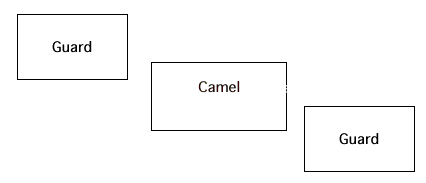"Khartoum", the Camel Corps never used their camels for cover! Nor, as some wargamers might be tempted to do, did they ever fight mounted as cavalry. From the beginning they were conceived of as a mounted infantry force, and fought as mounted infantry.
In a memorandum dated 27th October, 1884 and signed by Redvers Buller, the following guidelines were issued:
- "The soldiers of the Camel Regiments will fight only on foot. They are mounted on camels only to enable them to make long marches. The camel is a good traveller; but he is a slow mover.
He cannot be managed as easily as a horse, and he cannot be mounted, or dismounted From, with great rapidity. The men of the Camel Corps must therefore trust dolely to themselves and their weapons when once they have dismounted, This cannot be too strongly impressed upon the men. If we have to fight in the Sudan, we must expect to meet an enemy far outnumbering us, and who may at first charge recklessly home, apparently regardless of the intense fire we bring to bear upon him.
...The attack formation far infantry of our Drill Book is not intended to be employed against an enemy like the Arabs of the Sudan, It is designed to enable infantry to advance with the least possible lost over ground swept by a heavy fire from guns and rifles of an enemy as well armed and disciplined as ourselves, against whom an advance in close order would be impossible.
In acting against Arabs who are Indifferently armed and bad shots, the open formation of the grill Book is not necessary." (Colville, II, p.240).
 Contrary to the portrayal in the movie When under attack the Camel Corps dismounted and lashed its camels' knees together, thus eliminating the need to keep "horse-holders" back per regular mounted infantry. The camels were placed In "a compact formation under guard" (see below) and the main force would march away to battle so as to keep the camels From being brought under fire.(Colville, V.I., p. 102).
Contrary to the portrayal in the movie When under attack the Camel Corps dismounted and lashed its camels' knees together, thus eliminating the need to keep "horse-holders" back per regular mounted infantry. The camels were placed In "a compact formation under guard" (see below) and the main force would march away to battle so as to keep the camels From being brought under fire.(Colville, V.I., p. 102).
At Abu Kru, however, the Column Has caught unaware and had to hastily construct a zariba of boxes and saddles keeping the camels inside of the square itself.
The Royal Engineers were brought along to help construct earthworks like the stone forts surrounding the wells at Gakdule, as well as to work the pumps used to bring the water out of the wells. Occasionally they built smaller squares for the camels or wounded away from the main square, and often times the Naval Brigade's Gardner gun was placed in these smaller squares.
At Abu Klea the Column made the mistake of sending out skirmishers to cover the square, The Mahdists advanced so fast, and the square had to hold fire until the skirmishers got into the square, that only a few volleys were fired before the Mahdists engaged the British in hand-to-hand fighting. The cavalry was reserved for scouting. The guns were usually put in the corners of the square, or placed in smaller fortified zaribas outside of the main square.
The Desert Column
Back to Table of Contents -- Savage and Soldier Sudan Special Issue
Back to Savage and Soldier List of Issues
Back to MagWeb Magazine List
© Copyright 2004 by Milton Soong.
This article appears in MagWeb (Magazine Web) on the Internet World Wide Web.
Other articles from military history and related magazines are available at http://www.magweb.com